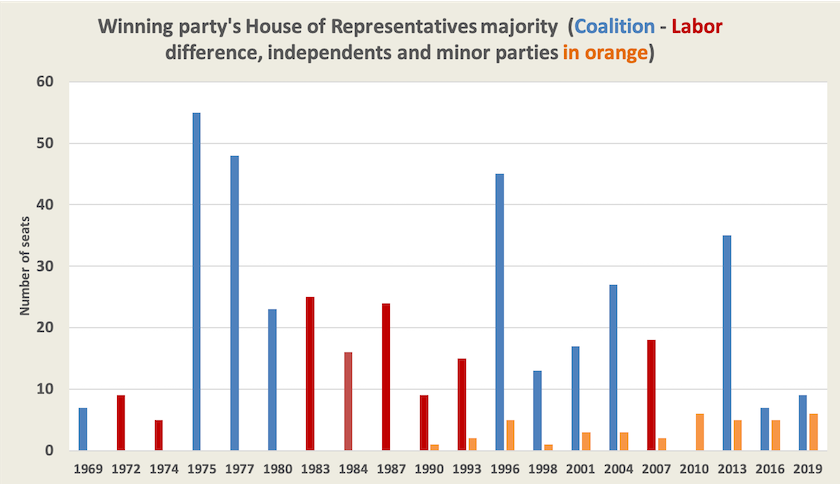The long election campaign
Cautious and inconclusive speculation
On last week’s Saturday Extra Geraldine Doogue interviewed Samantha Maiden of news.com.au and ABC’s election analyst Antony Green on the Liberals’ strengths and weaknesses as the federal election approaches. In a 23-minute discussion they reflect on the Coalition’s outstanding success in Western Australia and Queensland in 2019, and wonder what forces will shape the 2022 election. What will be the effect of states’ assertiveness and power in dealing with the pandemic? Will Palmer be as influential as he was in 2019?
Maiden makes little mention of the difficulties facing Morrison – the divisions between the National and Liberal Parties, the divisions within the Liberal Party, his failures in vaccination and quarantine, and his loose relationship with the truth. She acknowledges that he has a trust deficit, but believes he will try to turn that into a question about “trust” to run the economy.
Green points to the task ahead for Labor if it is to win majority government. A consideration of seats and margins suggests that it is a big challenge. He is wary, however, of any predictions based on national polls showing an X percent swing towards Labor. If 2019 is any guide, some swings in individual seats could be quite large.
In the discussion there is some recognition that neither Labor nor the Coalition may win majority government, but this is expressed in the language of a “hung parliament”, as if it is something odd and dysfunctional. As the graph below shows, however, we had better get used to the presence of independents and small parties, particularly the Greens for now, who will possibly hold more seats in the House of Representatives than the margin enjoyed by Labor or the Coalition.

Note that the presence of minor parties and independents in the House of Representatives is a comparatively recent phenomenon. As the combined Labor plus Coalition vote has fallen over the long term, more independents and minor parties are winning enough votes to get them over the line. Also note that in 2010 there is neither a red nor a blue column on the graph: the Gillard Government managed a substantial legislative agenda without a majority.[1].
Writing in Pearls and Irritations – Our two-party system is corrupt: vote for decency instead – Julian Cribb describes the emerging pattern of Australian politics, but few people are noticing:
Neither the parties nor the national media display much grasp of the emerging multi-spectral character of Australian politics, in which hung parliaments, complex alliances of minor parties and negotiation with a multiplying throng of independents form the central dynamic. A fairer, more representative, Scandinavian-type political scene rather than the corrupt old British class-based two-horse race we’re used to.
1. One qualification. In the 1966 election Sam Benson, who had previously served as an elected Labor member was expelled from the party and was elected for one term as an independent.. ↩
Can the media please give us a better election campaign coverage?
Margaret Simons, writing in Inside Story – Here we go again – laments the media’s role in recent federal election campaigns. “This time the election campaign needs to be reported differently” she writes. She cites US research, which aligns with Australian experience, revealing that journalists largely confine their reporting to political tactics and strategy, rather than the policy issues at stake.
John Hewson, in his regular contribution to the Saturday Paper – Scott Morrison’s election lies – also laments the lack of attention to policy in our political debates. He sees the problem in terms of Morrison’s single concern to win elections rather than dealing with policy issues. He writes:
Politics should be a contest of ideas, of alternative visions for the future, based on evidence rather than exaggerations, lies, fear and clever slogans. Under Morrison, it is everything but.
If, as is likely, Morrison tries to turn the election into a campaign about economic competence, and uses made-up figures to discredit Labor’s costings, we would be well-served if the media could allocate to the campaign its journalists with economic knowledge.
In the 2019 campaign even the ABC coverage of economic issues was poor. Most journalists were fixated on fiscal estimates rather than the broad scope of economic policy: it was apparent that many did not understand the crucial difference between fiscal management and economic management, allowing the government to escape scrutiny on important issues of economic structure. Journalists consistently allowed ministers to have the last and generally misleading word in interviews. Few journalists turned to academics and other experts to help clarify issues to the public. Many seemed to be more concerned to win gotcha points rather than to expose real deficiencies in politicians’ economic proposals. No wonder Morrison had an easy run back into office.
Albo on Labor’s policy principles
On last Monday’s 730 Report Anthony Albanese faced some assertive questioning by Leigh Sales – questions that seemed to be designed to get Albanese to articulate hard policy “positions” rather than to explain Labor’s policy principles. Albanese, however, managed to turn the discussion toward Labor’s principles, particularly around ways to lift real wages, including the social wage, through Medicare, housing affordability and child care.
He also took the opportunity to outline Labor’s vision on dealing with climate change through developing new industries, and to deconstruct the Coalition’s groundless claim that it has handled the pandemic well. (10 minutes)